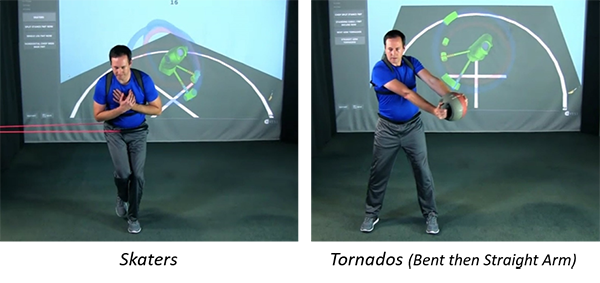By Jason Meisch
For an overview of the importance of deceleration training, see the author’s previous article, which makes the relevant issues clear for readers and their clients through colorful analogies and commonsense examples. -KMI Editorial
Why Screening is Key
Before writing a training program at our facility we screen all of our clients, and of course the screens vary by ability level and injury history. We commonly use a mix of TPI, SFMA, FMS, and manual muscle testing. By screening everyone it allows us to start athletes in a more appropriate space—gauging this starting point by what their body tells us, not by what we would guess based upon ability level. We have high handicaps that move very well, low handicaps that move very poorly, and any and every mix in between. That’s why we screen.
Some of our favorite introductory drills are:

One of the great things about performing such drills in K-VEST is that though different clients struggle with different parts of movements, through a click of a button I can change the feedback from forward/backward bend to sidebend and/or rotation. We may select a single drill and then use as many as six different types of biofeedback metrics with our clients.
Drills for Acceleration and Deceleration
Once players demonstrate a knowledge of pelvic and thoracic stability, we start training the full variations of acceleration and deceleration training. From here we will add drills such as:
We will also typically add “Bounding with Sticks,” in which players must prove they are in balance before going to the next location, and other landing drills. With all these drills, we’re watching players land and making sure they can hold the position when they land. If they hop or don’t stick the landing, we initially reduce the height or distance covered.
Finally, we will try to increase the reps per second of drills such as lunges, body weight squats, and so on. Some K-VEST drills that we may use to achieve power through deceleration are:

All of these drills force the player to accelerate and decelerate as fast as possible. We also tend to use lighter weights in our medicine balls, free weights, and kettlebells for the other acceleration and deceleration training. This is because we want our clients to train at greater speeds so they become comfortable slowing down these greater speeds.
Why Clients Hate Deceleration Training… Then Love It
It seems that one of the main reasons deceleration training is often overlooked is because it’s easier to train acceleration and measure the resulting improvements. Also, players feel like they’re able to progress to a greater workload faster than when they work on deceleration training.
Yet where does truly new training occur, the type that delivers breakthroughs in performance? In my experience I’ve found that when they are working harder on deceleration, players actually have more muscle soreness—but in parts of the body where they have never experienced it. This finding applies across the board, from our junior program to our oldest clients. Because of this soreness achieved through a “lighter” workload, players do not always like the deceleration workouts… until they see the results in club head speed and distance.
Make no mistake: deceleration training is difficult. When we train here our rule of thumb is, whatever you think a person should be able to do, back it down 2-3 levels and start there.
Sometimes as trainers we have to take a step or two back ourselves in order to make the march forward with our players that much more successful. The end result of all training is, of course, better performance, but we also want to keep players healthy. So if we do acceleration training exclusively, without giving athletes the ability to slow down and control those greater speeds, sooner or later the brakes will give out and they will crash. Don’t forget—the brakes are important!

Jason Meisch is the co-founder of PEAK Golf Fitness, having earned his BS in Athletic Training from Saginaw Valley State University and continuing his studies in Exercises Physiology at Western Illinois University. He has ten years’ experience in physical screenings and movement assessments, 3D motion assessments, and program design, and an additional five years’ experience in injury prevention and rehabilitation.
Currently a 3D golf movement consultant for many instructors worldwide, including four of Golf magazine’s Top 100 Instructors, Jason is also a K-VEST Advisory Board Member as well as instructor of the Level 3 Certification Seminar, teaching the analysis and live correction of golf-related issues such as identifying the possible cause of injury during the swing.
Jason also runs a Junior Performance Academy that has helped many of its students earn Division I golf scholarships. Other than golf, Jason has played baseball, basketball, and ice hockey. He also bowled in college at SVSU and WIU where, in 2004, his team made it to the Final Four of the Intercollegiate Bowling Championships.
The MLB Winter Meetings brings together baseball executives, coaches, media, exhibitors and job seekers from around the world to network, fill job openings, attend educational workshops and discuss innovating trends in the industry. It’s one of the highlights of our…
Agreement to Accelerate Improvement Across All Levels of the Organization (SCOTTSDALE, Ariz.) K-MOTION – the leader in 3D evaluations and biofeedback training solutions for coaches and athletes – announces an agreement with the Baltimore Orioles to become the organization’s Player…
By Joe DiChiara and Jason Meisch You take a swing and don’t like where the golf ball goes. You want to know what happened, so you turn to your launch monitor. You look at the club face numbers. They tell…